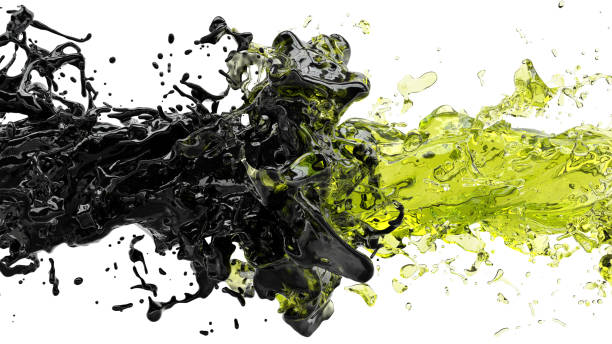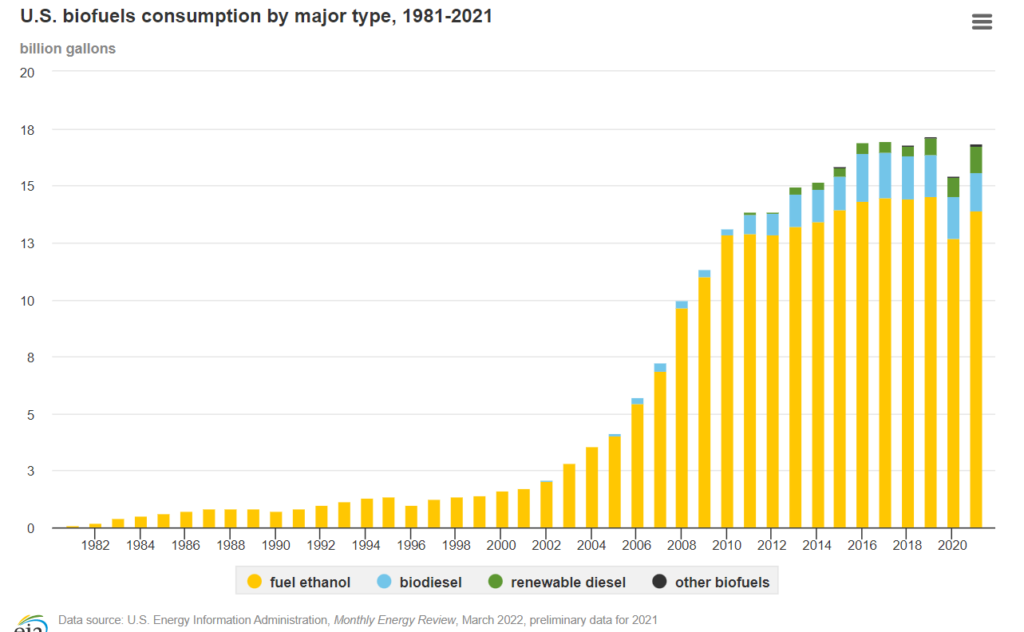
The numbers indicate that biofuel emits more harmful emissions than regular production. The same goes for ethanol by adding cost, lowering mpg, and damaging engines. As with many renewable projects, they do more harm and cost consumers more in the name of “renewables.” Per the EIA, in 2021, the average cost of biodiesel was $2.00 more than regular diesel. Is that extra cost passed on to the consumers worth the potential negative impact on the environment?
The numbers don’t align with positive indications of any benefit from biofuels. If they did show positive reductions in greenhouse gasses, the decision to use biofuels would be easy. Let’s do everything we can to save the environment.
The U.S. Energy Information Administration (EIA) publishes data on four major categories of biofuels that qualify for use in the federal RFS Program:1
- Ethanol—an alcohol fuel that is blended with petroleum gasoline for use in vehicles and accounted for the largest shares of U.S. biofuel production (85%) and consumption (82%) in 2021.
- Biodiesel—a biofuel that is usually blended with petroleum diesel for consumption and accounts for the second-largest shares of U.S. biofuel production (11%) and consumption (12%) in 2021.
- Renewable diesel—a fuel chemically similar to petroleum diesel fuel for use as a drop-in fuel or a petroleum diesel blend with small but growing U.S. production and consumption. Renewable diesel’s percentage shares of total U.S. biofuels production and consumption were about 3% and 5% respectively in 2021.
- Other biofuels—include renewable heating oil, renewable jet fuel (sustainable aviation fuel, alternative jet fuel, biojet), renewable naphtha, renewable gasoline, and other emerging biofuels that are in various stages of development and commercialization.

In her article “Converting a petroleum diesel refinery for renewable diesel”, Erin Chan published the following:
However, time-to-market is not the only factor to consider when choosing whether to convert an existing unit or build a new one. To determine if an existing unit is a good fit for a conversion, it is important to evaluate the condition and usability of its existing equipment and ancillary systems. Process simulations and other analyses will likely be needed to demonstrate the viability of a conversion project. Some factors to consider include:
- High reaction exotherm—Whether using agricultural waste or crude oil, a hydrotreater’s reaction releases heat when breaking chemical bonds in the feedstock. However, renewable diesel reactions are significantly more exothermic than petroleum diesel desulfurization reactions. Therefore, it is important for these units to be equipped with high liquid product recycle capacity that can be used to absorb this heat. It is also necessary to recalibrate production expectations based on the high product recycle through the unit. A hydrotreater that operates at 50,000 bpd for petroleum diesel production may only be able to accommodate 5,000 bpd of fresh feed when converted to renewable diesel.
- Emergency depressurization systems—Because of the high heat release associated with renewable diesel reactions, hydrotreaters require emergency depressurization systems to manage the reaction safely in the event the recycle and quench systems fail. These systems quickly depressurize the reactor to a flare, stopping the reaction.
- Hydrogen consumption—Renewable diesel reactions consume a significant amount of hydrogen. Therefore, refineries with excess hydrogen capacity are particularly good candidates for conversion projects. Refineries with limited hydrogen availability may need to budget for the construction of an additional hydrogen plant.
- Feed train considerations—Depending on the quality of the renewable diesel feedstock, it may be necessary
to upgrade the metallurgy in the unit’s feed train system. For example, feedstock that is high in free fatty acids has the potential to create a corrosive environment. Another special consideration for renewable feedstocks is the potential for polymerization in the feed train. When hydrogen is absent, renewable feedstocks can polymerize, which causes gumming and fouling in the equipment. The addition of hydrogen could make the equipment susceptible to high-temperature hydrogen attack. One option is to update feed-side metallurgy
to protect against corrosive conditions. Another is
to create two separate pre-heat trains, with separate systems for liquid recycle and fresh feed. - Water and carbon dioxide (CO2) production—Renewable diesel reactions produce water and CO2 in much larger quantities than petroleum hydrotreaters, creating potential carbonic acid corrosion concerns downstream of the reactor. Metallurgy upgrades may be required in the reactor effluent air cooler system. Consideration must be given to the handling, treatment and disposal of the extra water and CO2 produced in these reactions. For example, if water is routed to the refinery’s sour water stripper, it may produce high concentrations of carbonic acid in the sour water streams, impacting how the water is treated and reused.
- Heat tracing—The vegetable oils and animal fats used as feedstock become waxy and solidify at ambient temperatures. To load them into trucks and rail cars for shipment and, later, unload and charge them to a hydrotreating unit, these feedstocks must be in liquid form. That requires steam or electric heat tracing systems that raise the temperature of pipes, tanks and vessels to liquefy the fats and oils. The addition of significant heat tracing capacity will likely be required for both existing hydrotreating infrastructure, as well as the rail, truck or barge piping and equipment used to store and transfer feedstock into the unit.
Any of these factors could potentially give a refiner pause on a renewable diesel conversion project. More likely, they will provide insight on the right way to move forward.
When creating biofuels, massive amounts of heat are required. Currently, fossil fuels are the primary source of heat for manufacturing. The manufacturing time on biofuels is longer, uses more energy, and emits more CO2 introduction.
A key statement from the EIA is; “However, according to international convention, CO2 emissions from biofuel combustion are excluded from national greenhouse gas emissions inventories because growing the biomass feedstocks used for biofuel production may offset the CO2 produced when biofuels are burned.
The effect that biofuel use has on net CO2 emissions depends on how the biofuels are produced and whether or not emissions associated with cropland cultivation are included in the calculations. Growing plants for fuel is a controversial topic because some people believe the land, fertilizers, and energy used to grow biofuel crops should be used to grow food crops instead.”
Several key words: ..biofuel production MAY offset the CO2 produced… Calculating farming, fertilizer, and resources required to get the bio mas to the refineries is not calculated into the benefit statements.
The true account of actual costs and environmental impact is intentionally left out to better move the political agenda for renewable energy. The E85 containing 83% ethanol content has around 27% less energy and shortens the engine’s life.
So let’s ask the question. In 2021 the United States used 13.94 billion gallons of ethanol with an estimated 27% less energy. Do the additional heat, fuel, transportation, and tax credits required to reduce greenhouse gasses actually work? Or is the entire biofuel market an effort to feel good and gain votes? Just askin.
If the biomaterial is sourced right, it may be a fantastic solution, and these discussions are greatly needed.


